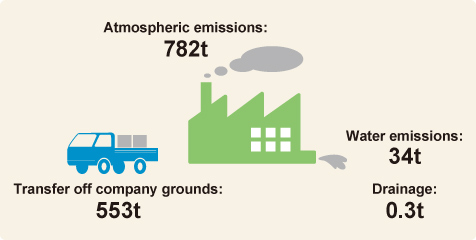Home > About Us > Sustainability Management > Sustainability Report > Sustainability Report 2015 > Appropriate Management of Chemical Substances
 Appropriate Management of Chemical Substances
Appropriate Management of Chemical Substances
The Kobe Steel Group carries out thorough and appropriate management of chemical substances, in line with domestic and international standards, and endeavors to reduce the use of hazardous substances and replace such substances with safer alternatives.
Thorough Chemical Substance Management
![]()
Kobe Steel has established the Kobe Steel Group Policy on Controlling Hazardous Chemical Substances and pursues thorough chemical substance management.
The use and management of each substance is clarified through Designated Chemical Substance Management Sheets. In addition to tallying transfer and output of substances as required by the PRTR Law1, we also engage in initiatives to limit the use and output of such substances.
According to reported figures collected under the PRTR Law for each location in the Kobe Steel Group (in Japan), the Kobe Steel Group handled 51 substances, with a total output2 of approximately 816 tons, and total transfer3 of 553 tons.
Kobe Steel Group Output/Transfer of Substances

- 1. The Pollutant Release and Transfer Register Law.
- 2. Output includes atmospheric and water emissions.
- 3. Transfer includes transfers of substances off of company grounds and drainage.
Complying with Chemical Substance Regulations
![]()
Both within and outside Japan, worldwide regulations on chemical substances are growing stronger. The Kobe Steel Group complies in an appropriate manner with these laws and regulations.
As shown by the table below, the Group continues to work toward reducing chemical substance output. In order to ensure compliance with relevant laws and regulations, we also share information and opinions between departments.
Examples of Activities to Reduce Chemical Substance Emissions
| Site/company name | Location | Examples of initiatives |
|---|---|---|
| Kakogawa Works | Kakogawa, Hyogo Prefecture | Introduced thinner recycling equipment at plant, reduced purchasing of thinner |
| Saijo Plant | Higashihiroshima, Hiroshima Prefecture | Switched to low organic solvent substance for welding rod color-coding paint (on rod tips), reduced usage of organic solvents |
| Harima Plant | Kako-gun, Hyogo Prefecture | Switched to non-PRTR substances for antirust agents |
| Kobe Corporate Research Laboratories | Kobe, Hyogo Prefecture | Switched a portion of test-use organic solvents over to ethanol |
| Shinko Metal Products Co., Ltd. | Kitakyushu, Fukuoka Prefecture | Replaced chlorine-based organic solvent cleaning solution with non-PRTR substances |
| Shinko Leadmikk Co., Ltd. | Kitakyushu, Fukuoka Prefecture | Increased usage life of stripping solution and reduced waste through removal of contaminants |
| Kobelco Research Institute, Inc. | Kobe, Hyogo Prefecture | Mixed in non-PRTR substances for test piece preparations, reduced usage of chemical substances |
| Kobelco Eco-Solutions Co., Ltd. | Kako-gun, Hyogo Prefecture | Replaced washing chemicals with non-PRTR substances |
Management of Waste Electrical Equipment Containing PCB
![]()
Transformers, condensers and other used equipment containing PCB (polychlorinated biphenyl) are handled at a special depository, as prescribed under the PCB Special Measures Law.
When contracting for outside disposal, we visit sites directly and train persons-in-charge in proper management rules. Oversight is also carried out by the Environmental Control & Disaster Prevention Department.


